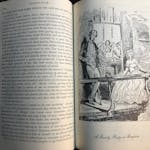The Midwest, according to conventional wisdom, is the quintessential American region. Insulated and isolated, stable and inward-looking, it exemplifies our nation's essence — and exceptionalism — through its people, principles and practices. The Midwest is the America of America First.
In "The Heartland," Kristin Hoganson, a professor of history at the University of Illinois, Urbana-Champaign, and the author, among other books, of "American Empire at the Turn of the Twentieth Century," debunks these claims.
Using Champaign County as her paradigmatic example, Hoganson demonstrates that for hundreds of years, the heartland's rural and small-town communities have been "thoroughly riddled with histories of foreign relations."
She also maintains, more provocatively, that when the Midwest is examined as a "real, bloody, beating thing," instead of a nostalgic Victorian silhouette, the region helps us understand settler colonialism, the wellsprings of empire, contests between "insiders and people on the margins," and struggles for justice and freedom.
Hoganson has searched far and wide for evidence of Champaign's global connections and imperial entanglements. Illinois farmers, she indicates, looked to Canada for cattle to breed and to Mexico for animals to fatten. They invested in Berkshire hogs, ignoring their semi-feral and Asian ancestry, to associate themselves with Anglo-Saxon racial purity; refusing to accept blackness as an adequate standard for the pigs, a prize essay praised animals with "white feet, faces, tips of the tail, and an occasional splash of white on the arm." Meteorologists connected hurricanes, cyclones and tornadoes to far-flung places such as Jamaica and the Philippines. Similarly, Hoganson writes, migratory birds established Illinois "as a place in the middle, a place of encounter."
"The Heartland" begins and ends with the Kickapoos. As the white pioneers displaced the Indians, Hoganson reminds us, they used histories, societies and laws to make the locality theirs. With an eye, no doubt, on President Donald Trump, she endorses the Kickapoo claim that place is always relational and true security "does not emerge from walling people in and out, but from extending human rights and justice."
"The Heartland" is awash in interesting and fresh information. Hoganson's thesis, however, is not entirely persuasive. Readers sympathetic to conventional wisdom about the Midwest may see little in the book to convince them that the region is not more insulated and isolated, stable and inward-looking than other places in the United States. Nor does Hoganson make a compelling case that her accounts of searches for products and markets, weather forecasting and birds provide bricks in the edifice of American imperialism.
That said, Hoganson is surely right that some aspects of the heartland myth are better left behind. And to challenge us to look outward and inward at the same time and respect near and distant strangers.
Glenn C. Altschuler is the Thomas and Dorothy Litwin professor of American studies at Cornell University.






